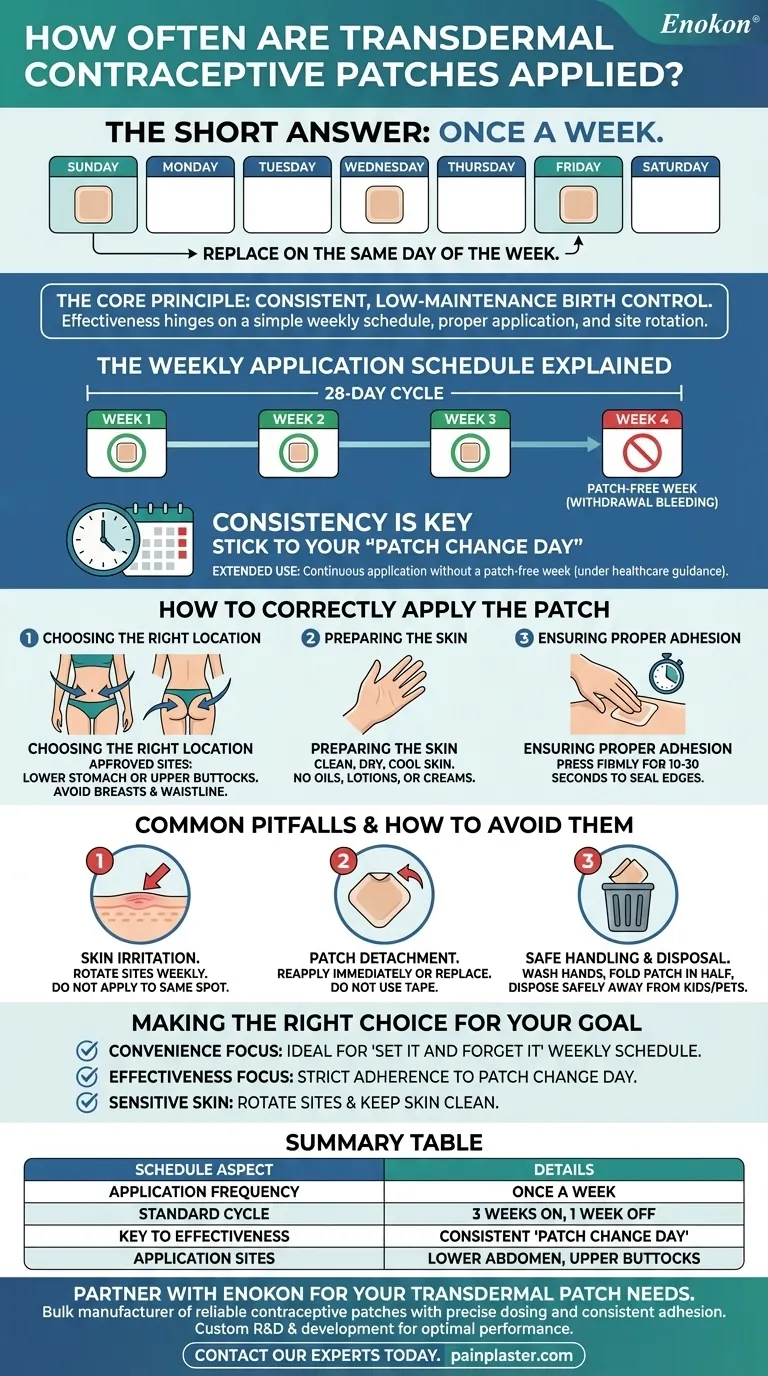The short answer is this: Transdermal contraceptive patches are designed to be applied once a week. You wear one patch for seven days and then replace it with a new one on the same day of the week, continuing this cycle for three consecutive weeks.
The core principle of the contraceptive patch is providing a consistent, low-maintenance method of birth control. Its effectiveness hinges on a simple weekly schedule, but proper application technique and site rotation are critical to prevent skin irritation and ensure hormonal delivery.

The Weekly Application Schedule Explained
Understanding the cadence of the patch is the first step to using it effectively. It’s designed to fit into a routine, removing the need for daily action required by other contraceptive methods.
The Standard 28-Day Cycle
The most common usage follows a four-week (28-day) cycle. You apply a new patch once a week for three weeks in a row. This is followed by one week without a patch, during which you will likely experience withdrawal bleeding, similar to a period.
Extended or Continuous Use
Some users, under the guidance of a healthcare provider, opt for an extended cycle. This involves applying a new patch weekly without a patch-free week, which can reduce the frequency of withdrawal bleeding.
Consistency is Key
The most important element is establishing a consistent "patch change day." If you apply your first patch on a Sunday, all subsequent patches should be changed on a Sunday. This routine is crucial for maintaining the correct hormone levels for pregnancy prevention.
How to Correctly Apply the Patch
Where and how you apply the patch matters just as much as when. Proper application ensures the patch adheres securely and delivers the medication effectively for the full seven days.
Choosing the Right Location
Apply the patch to clean, dry, and cool skin. The approved locations are the lower stomach (abdomen, below the waistline) or the upper buttocks. These areas have good blood flow and are less prone to friction from clothing.
Preparing the Skin
Do not use any oils, lotions, or creams on the area where you plan to apply the patch, as this will prevent it from sticking properly. The skin should not be irritated, damaged, or broken.
Areas to Avoid
You should never apply the patch to your breasts. Also, avoid placing it along the waistline or the lower part of the buttocks where tight clothing or sitting could cause it to rub off or loosen.
Ensuring Proper Adhesion
After placing the patch, press down firmly on it with the palm of your hand for about 10-30 seconds. Make sure the edges are stuck down completely to create a secure seal.
Common Pitfalls and How to Avoid Them
While the patch is convenient, a few common issues can arise. Being aware of them helps you maintain maximum contraceptive effectiveness.
Skin Irritation
To prevent skin irritation, it is essential to rotate your application site. Never apply a new patch to the exact same spot of skin as the previous one. A good practice is to alternate between the left and right sides of your body each week.
Patch Detachment
If a patch becomes loose or falls off completely, you should try to reapply it immediately. If it won't stick, replace it with a new patch right away. Do not try to hold a loose patch in place with tape.
Safe Handling and Disposal
Always wash your hands before and after applying a patch. When you remove a used patch, fold it in half so the sticky sides stick together. This seals in any remaining medication. Dispose of it safely in the trash, out of reach of children and pets.
Making the Right Choice for Your Goal
The transdermal patch is an excellent option for many, but its suitability depends on your personal priorities and lifestyle.
- If your primary focus is convenience: The "set it and forget it" weekly schedule is ideal for anyone who finds it difficult to remember a daily pill.
- If your primary focus is effectiveness: Strict adherence to your weekly "patch change day" and ensuring proper adhesion are the most critical factors for success.
- If you have sensitive skin: A commitment to rotating application sites and keeping the skin clean and dry is necessary to prevent potential irritation.
Ultimately, understanding the simple weekly rhythm of the contraceptive patch empowers you to use this method correctly and confidently.
Summary Table:
| Schedule Aspect | Details |
|---|---|
| Application Frequency | Once a week |
| Standard Cycle | 3 weeks on, 1 week off |
| Key to Effectiveness | Consistent "Patch Change Day" |
| Application Sites | Lower abdomen, upper buttocks |
Partner with Enokon for Your Transdermal Patch Needs
As a bulk manufacturer of reliable transdermal patches for healthcare and pharmaceutical distributors and brands, Enokon understands the critical importance of precise dosing and consistent adhesion for products like contraceptive patches. Our technical expertise in custom R&D and development ensures your product delivers optimal performance and user convenience.
Ready to develop or source high-quality transdermal patches? Contact our experts today to discuss your project requirements.
Visual Guide

Related Products
- Prostate Pain Kidney Health Care Patch for Men
- Capsaicin Chili Medicated Pain Relief Patches
- Far Infrared Deep Heat Relief Patches Medicated Pain Relief Patches
- Heating Pain Relief Patches for Menstrual Cramps
- Far Infrared Heat Pain Relief Patches Transdermal Patches
People Also Ask
- How often should testosterone patches be applied? Daily Dosage & Best Practices
- What should patients tell their doctor before using testosterone patches? A Guide to Safe Treatment
- What precautions should be taken when applying testosterone patches? Maximize Safety and Effectiveness
- What should be done in case of a testosterone patch overdose? A Step-by-Step Emergency Guide
- What should be done before undergoing an MRI while using testosterone patches? Remove it to prevent serious burns.














